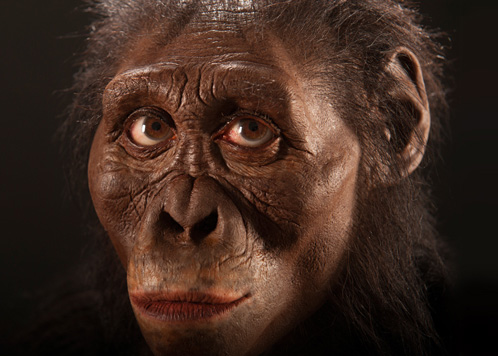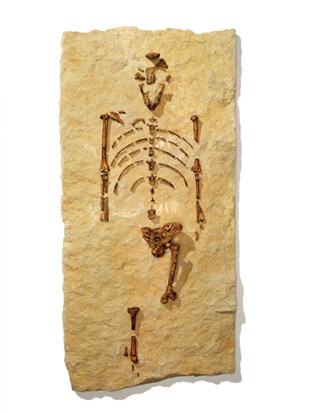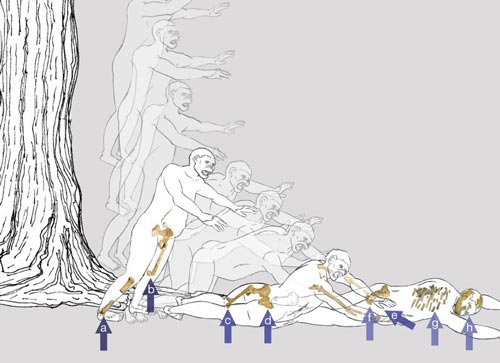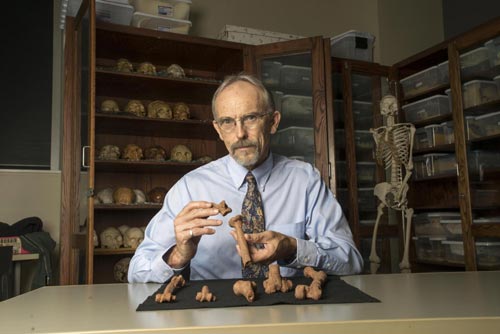“Lucy” Died after Tree Fall
“Lucy” Most Likely Died after a Fall from a Tree
A team of researchers from Ethiopia and the United States have published a remarkable post-mortem on one of the most famous hominin fossils known to science. It turns out that the 3.2-million-year-old Australopithecus afarensis known as “Lucy”, very probably died from injuries resulting from a fall from height, most likely a fall from a tree.
Computerised Tomography and “Lucy”
Computerised tomography was employed to study the fossilised bones whilst the specimen was on tour of America (Lucy’s Legacy: The Hidden Treasures of Ethiopia). The high resolution scans helped the scientists to determine which of the many fractures in the bones related to injuries and which ones were as a result of more than three million years preserved in strata.
A Reconstruction of an Australopithecus afarensis Based on Fossil Material
Perimortem Fractures
Lead author of the scientific paper, which has just been published in the journal “Nature”, Professor John Kappelman (University of Texas) explained:
“These fractures have been known since she was discovered. I’ve looked at this fossil for thirty years and I knew that these fractures were there.”
“Lucy” was discovered in the Afar region in 1974, ironically this hominin got her nickname as “Lucy in the Sky with Diamonds”, the Beatles tune from the album “Sgt. Pepper’s Lonely Hearts Club Band”, had been played repeatedly by the research team at the dig site.
“Lucy” Killed in a Fall
It seems that a fall killed her and as since the fossils are associated with a flood plain with trees, it seems highly plausible that “Lucy” fell out of a tree. This new study supports the idea that Australopithecus afarensis spent at least some of its time in the trees. However, adaptations to a more terrestrial life, especially bipedal locomotion may have limited this species in terms of their ability to climb trees. Being better adapted to walking upright meant a trade off between this and tree climbing ability. In the case of “Lucy” this was to lead to fatal results.
The Fossilised Remains of “Lucy” A. afarensis
Picture credit: The world’s most famous fossil, known as “Lucy,” went on display for the first time outside of Ethiopia in the world-premiere special exhibition Lucy’s Legacy: The Hidden Treasures of Ethiopia.
A Dramatic “Vertical Deceleration Event”
The scans revealed a number of perimortem injuries (pathology related to death or shortly before death), particularly a crushed shoulder joint, consistent with a person reaching out their arms to try and break their fall. The scans also revealed traumatic injuries to the ankle, leg bones, the kneecap, pelvis, ribs, skull, jaws and backbone. When the research team examined these injuries and compared them to orthopaedic literature in relation to fall victims, the team found striking similarities between the fractures.
Commenting on how certain the researchers were with regards to the fall from height (vertical deceleration event), Professor Kappelman stated that the team’s hypothesis:
“It’s tested every day in emergency rooms all around the planet.”
“Greenstick Fractures”
A number of the perimortem fractures identified were “greenstick” breaks. The bone had bent and snapped like a branch of a tree, something that only happens to healthy, living bones. The scientists concluded that these traumatic injuries occurred when Lucy was alive, as they show no signs of healing and as the injuries were so catastrophic, they very probably all occurred at the same time, a consequence of a fatal accident.
The fatal fall also fits with the fact that Lucy’s tiny first rib is broken. This small bone is heavily protected by the chest, if this is broken in an accident, as Professor Kappelman explains: “you’re having a bad day.”
A Shattered Shoulder Joint and Other Injuries
When the shattered shoulder joint was examined the team concluded (after reviewing the evidence with orthopaedic surgeons), that Lucy had tried to break her fall by reaching out her arms, as Professor Kappelman explained: “if our hypothesis stands up… it tells us that Lucy was conscious when she reached out her arms to break her fall.”
The Postulated Demise of “Lucy” – A Fall from a Tree
Picture credit: University of Texas
A Severe Impact
In a remarkable analysis the researchers plot the demise of Lucy and comment when each of her injuries was likely to have occurred. The impact would have been so severe as to cause concomitant fractures usually such a fall would also damage internal organs; together, these injuries are hypothesised to have caused her death.
When fossils of Australopithecines are examined they appear to have been capable of both terrestrial and arboreal locomotion. The authors suggest that the adaptations that facilitated bipedal, terrestrial locomotion compromised the ability of individuals to climb safely and efficiently in the trees. This combination of features may have predisposed these hominins to more frequent falls from height.
Looking for Signs of Injury
Close inspection of other fossils for signs of injury has the potential to offer important insights about hominin lifestyle, through an understanding of the trauma that they suffered and the mechanisms by which they died.
With the cooperation of the Ethiopian Government a series of data files have been produced and made freely available to other researchers. In addition, as a result of the 45,000 scans taken by the team, a number of bones from Lucy have been reconstructed, these too will provide valuable learning resources.
Professor Kappelman in His Anthropology Laboratory with Casts of “Lucy’s” Bones
Picture credit: University of Texas
“Lucy” and her kind the Australopithecus afarensis have been at the centre of a vigorous debate amongst palaeoanthropologists. How much time did these hominins spend in the trees? It is ironic therefore, to hypothesis that “Lucy” died as a result from a fall, probably out of a tree. The fractured bones providing evidence of arborealism within this species. This is one very “cold case” that may have been cracked.
One further question to ask, did “Lucy” fall or was she pushed?
To read an additional article on bipedalism in early hominins: Early Hominins Walked Upright so they could Carry more Food.





